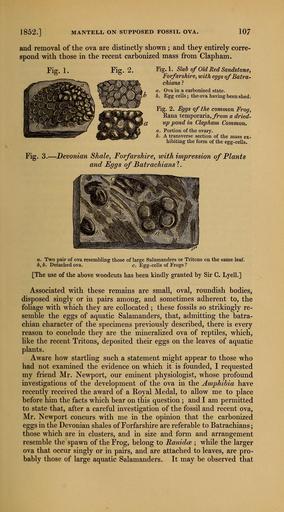MAKE A MEME
View Large Image

| View Original: | The_Quarterly_journal_of_the_Geological_Society_of_London_(12684250433).jpg (1773x3200) | |||
| Download: | Original | Medium | Small | Thumb |
| Courtesy of: | commons.wikimedia.org | More Like This | ||
| Keywords: The Quarterly journal of the Geological Society of London (12684250433).jpg 1852 <br> MANTELL ON SUPPOSED FOSSIL OVA <br> 107 <br> and removal of the ova are distinctly shown ; and they entirely corre- <br> spond with those in the recent carbonized mass from Clapham <br> Fig 1 <br> Fig 2 <br> Fig 3 - <br> Fig l Slab of Old Red Sandstone <br> Forfarshire with eggs ofBatrU' <br> chians <br> a Ova in a carbonized state <br> b Egg cells ; the ova having been shed <br> Fig 2 Eggs of the common Frog <br> Rana temporaria /rom a dried- <br> a f P pond in Clapham Common <br> a Portion of the ovary <br> b A transverse section of the mass ex- <br> hibiting the form of the egg-cells <br> -Devonian Shale Forfarshire with impression of Plants <br> and Eggs of Batrachiansl <br> a Two pair of ova resembling those of large Salamanders or Tritons on the same leaf <br> b b Detached ova c Egg-cells of Frogs <br> The use of the above woodcuts has been kindly granted by Sir C Lyell <br> Associated with these remains are small oval roundish bodies <br> disposed singly or in pairs among and sometimes adherent to the <br> foliage with which they are collocated ; these fossils so strikingly re- <br> semble the eggs of aquatic Salamanders that admitting the batra- <br> chian character of the specimens previously described there is every <br> reason to conclude they are the mineralized ova of reptiles which <br> like the recent Tritons deposited their eggs on the leaves of aquatic <br> plants <br> Aware how startling such a statement might appear to those who <br> had not examined the evidence on which it is founded I requested <br> my friend Mr Newport our eminent physiologist whose profound <br> investigations of the development of the ova in the Amphibia have <br> recently received the award of a Royal Medal to allow me to place <br> before him the facts which bear on this question ; and I am permitted <br> to state that after a careful investigation of the fossil and recent ova <br> Mr Newport concurs with me in the opinion that the carbonized <br> eggs in the Devonian shales of Forfarshire are referable to Batrachians; <br> those which are in clusters and in size and form and arrangement <br> resemble the spawn of the Frog belong to Banidce ; while the larger <br> ova that occur singly or in pairs and are attached to leaves are pro- <br> bably those of large aquatic Salamanders It may be observed that 35461109 109911 51125 Page 107 Text v 8 http //www biodiversitylibrary org/page/35461109 1852 Geological Society of London NameFound Amphibia NameConfirmed Amphibia EOLID 1552 NameBankID 2476588 NameFound Rana temporaria NameConfirmed Rana temporaria EOLID 331133 NameBankID 2476426 Biodiversity Heritage Library The Quarterly journal of the Geological Society of London v 8 1852 Geology Periodicals Smithsonian Libraries bhl page 35461109 dc identifier http //biodiversitylibrary org/page/35461109 smithsonian libraries Information field Flickr posted date ISOdate 2014-02-21 Check categories 2015 August 26 CC-BY-2 0 BioDivLibrary https //flickr com/photos/61021753 N02/12684250433 2015-08-27 13 00 48 cc-by-2 0 PD-old-70-1923 The Quarterly journal of the Geological Society of London 1852 Photos uploaded from Flickr by Fæ using a script | ||||